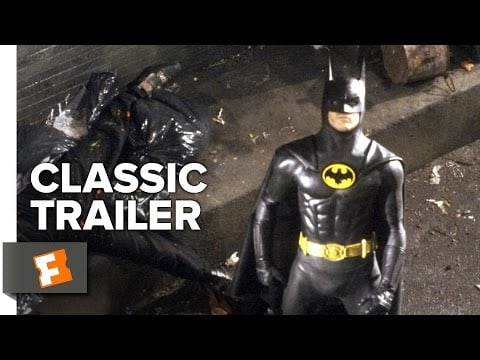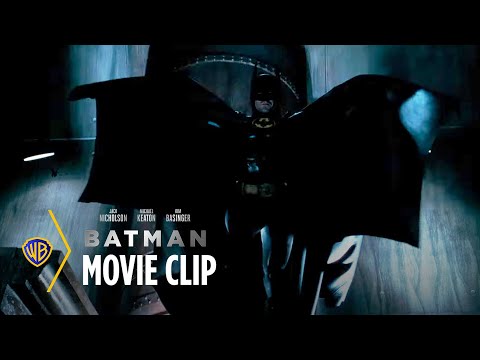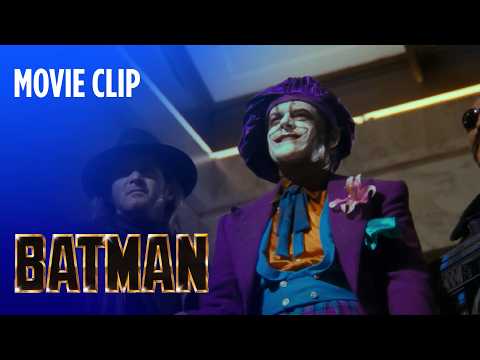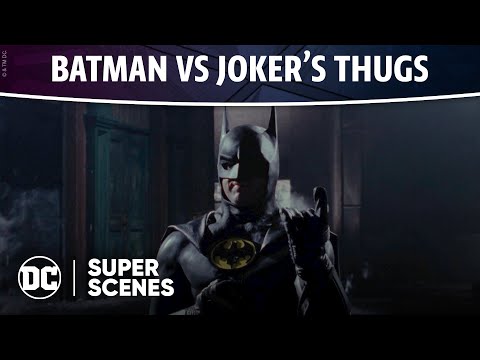Tim Burton’s “Batman” (1989) was such a monumental pop culture event, that it was easy for some to deem the film itself as an also-ran.
Pop culture immersion aside, many critics didn’t embrace Burton’s film nor his take on the character created by Bob Kane and Bill Finger. More specifically, they resisted a film with a marketing extravaganza dominance during the summer season and became the most ubiquitous surprise hit of the year.

“Batman” arrived among the most high-profile summer movie season ever, but it was in no way a sure thing.
Unlike competitors “Indiana Jones and the Last Crusade,” “Ghostbusters II,” “Lethal Weapon 2” and “The Karate Kid, Part III,” among others, “Batman” arrived after months of pre-release hype.
Not all of it was favorable.
Reports that the film was “serious,” not an extension of the knowingly silly “Batman” TV series starring Adam West (which aired from 1966-1968) and wouldn’t feature West, was met with skepticism. At one point in time, the live-action “Batman” series, with its ubiquitous theme song and campy dialogue, was how most knew the character.
Further reports that it would be Michael Keaton, arguably best known for “Beetlejuice” (1988) and “Mr. Mom” (1983), was a bigger blow. How dare they cast a comedy actor in the part of psychologically wounded Bruce Wayne!
Hate mail and protests famously arrived at the Warner Bros. gates.
RELATED: ‘BATMAN AND ROBIN’ – HOLY STINK BOMBS!
By the time June 23 arrived and the film opened, there was already heavy circulation of the Topps bubble gum series, the Prince song soundtrack, an action figure line, posters, shoelaces and that legendary trailer (yes, the rumors are true – bootleg copies of it sold for $100.00 at comic book conventions).
Did the film live up to a tsunami of hype? More on that later.
Stay tuned, Batfans.
“Batman” begins with Danny Elfman’s overture, a beautiful, soaring but somber score that establishes the angst at the center of the title character’s psyche.
We witness how violent crimes are on the rise in Gotham City, So are frequent appearances of “The Bat,” who is putting fear into the rat-like criminals at the bottom of the food chain. Near the literal top of the city, vile crime boss Gus Grissom (Jack Palance) assigns his right-hand man and “number one guy” Jack Napier (Jack Nicholson) to raid Axis Chemicals.
The Batman shows up, breaks up the ensuing gunfight and fails to save Napier from plunging in a vat of chemicals. Napier survives and reemerges as The Joker.
While the ongoing efforts of Batman bring balance to the city, a lauded reporter, Vicki Vale (Kim Basinger) discovers that Wayne, her new boyfriend, may have a connection to it all.

In the early scenes, a strong feeling of melancholy and nostalgia runs through the imagery: actors are donning 1940s attire and Anton Furst’s Oscar-winning art direction shapes Gotham City as an extension of Fritz Lang’s title setting of “Metropolis” (1927).
Burton’s feature is film noir and could easily have been shot in black and white. In fact, if a black-and-white version were to surface (as, for example, black-and-white variants of “The Mist” and “Mad Mad: Fury Road” have been released), the eyes would require very little adjustment.
As depicted here, Wayne is not suave or charismatic but socially awkward, soft spoken, kind of sweet and quite weird. Keaton dialed down his livewire, up for anything persona to play a truly haunted man.
His performance was a surprise in ’89 and still feels smart and dialed into the sad truths of the character. Keaton wisely never tries to make Wayne likable.
Nicholson’s performance was, perhaps less of a surprise, as his turn in “The Witches of Eastwick” (1987), for example, indicated he’d be perfect for The Joker. That is the case, though there’s more to the performance than just maniacal laughter and bad quips.
Napier is a career criminal, a suave lunatic with no moral compass. As The Joker, Nicholson carries over Caesar Romero’s laugh from the series but is otherwise playing a cinematic cousin to Jack Torrance (another Jack!) from “The Shining” (1980).
Criticism that Nicholson went over the top is ludicrous, as he’s playing The Joker. More notable is just how scary he is.

Nicholson’s performance and the film itself stop short of the kind of razor-rusted horror of, say, Grant Morrison’s magnificent, horrifying graphic novel, “Arkham Asylum: A Serious House on Serious Earth” (1989).
This isn’t an unbearable horror show, but, to give “Batman” the credit it deserves, Burton’s film embraces and matches the nihilism and character contrasts of Alan Moore and Brian Bolland’s savage 1988 graphic novel, “Batman: The Killing Joke.”
Post- “The Dark Knight” (2008) and “The Dark Knight Rises” (2012), this series would further explore the notion of heroism and sanity (as well as survive a deep dive into camp),
That all came later.
View this post on Instagram
In a canny bit of mirrored casting, Palance is playing the man who Napier hopes to become. As Alfred the Butler, Alfred Gough’s weary father figure was already a welcome presence (he’s the bright spot of the hit and mostly-miss 1997 “Batman & Robin”).
Playing the obnoxious reporter Alexander Knox, Robert Wuhl gives the role what it needs, though it also provides evidence that he’s a terrible reporter, which I’m not sure is intentional. The Joker’s assessment of Knox is one of my favorite lines of Nicholson’s: “Who is that loss? Bad tie. No style.”
Hugo Blick is unforgettable and truly frightening in his single scene as the young Napier.
Basinger is very good as Vale, though Sean Young (who had the role until she was recast early in filming) would also have been a good choice, She’s edgy enough to seem like a good fit for Wayne.
The actor who comes up short is Billy Dee Williams, whose scenes as Harvey Dent are initially promising but feel unfinished, as though a major subplot were cut down to the bare minimum.
Another criticism – why are The Joker’s henchmen all middle-aged, past-their-crime thugs who drive color-coded green and purple cars? They should be much easier for Commissioner Gordon to catch.
A contrivance I can forgive is how Vale is escorted into the Batcave to confront Wayne – I buy it on an emotional level, unlike Napier’s dependency on a crew of dumbfellas.

Burton’s epic comic book movie (which rescued the genre from a slump that started around 1983 with the lame “Superman III”) is big, gothic and operatic. It’s also quirky and is firmly a Burton film, giving the filmmaker an auteur identity early in his long career.
There are many awe-inspiring moments, such as Batman’s seemingly supernatural, upward ascension into mist. The museum “date” The Joker has with Vale is a riveting sequence. It begins as broadly funny and becomes unbearably dark until Batman arrives.
As a kid, there were few movie moments as thrilling as when Batman saves Vale from that defaced art museum.
The final confrontation between Batman and The Joker is enthralling – watch the sick joy Batman has in repeating a deadly catchphrase, then informing The Joker, “I’m going to kill you.”
There are surreal bits, like The Joker killing a rival in broad daylight using a poison quill and an army of mimes (!). The Joker TV ads are funny, until they become childish and sick, with the deadly implications of Smylex gas softened only somewhat by the dark humor (the body count rivals any Stallone or Schwarzenegger flick).
RELATED: THE MOST PERSONAL BATMAN STORY… EVER
In addition to the money shots that were intercut in the commercial for Batman – The Cereal (I’m not kidding), “Batman” is also loaded with nightmare fuel. Napier’s emergence from a vile plastic surgery session, literally electrifying a rival to death and, most devastating to witness, the poetic, horrifying murder of Wayne’s parents, are still jaw dropping today.
These bits, particularly the latter and the final reveal of Napier’s girlfriend, are among the scariest Burton has ever filmed.
In theaters and certainly in the soupy videocassette tape release (that arrived an astonishing four months later, a first for a major title), the film looked too dark at times. Thankfully, it’s been cleaned up subsequently and retains the mystery and dark mood.
We can finally see everything.
BATMAN (1989) was released 35 years ago today! https://t.co/ZyTZg9IlNp
— PopHorror (@PopHorrorNews) June 23, 2024
A chilling easter egg that was recently pointed out to me: eagle eyes will note in Napier’s crime folder, which features his current photos, there is a half-visible photo of the young Napier that can glimpsed. The movie doesn’t cheat on the Young Napier/ Young Wayne connection.
Nicholson is amazing in this and Keaton’s brooding, internalized performance provides the ideal contrast in character and acting styles.
“Batman” was a major pop culture phenomenon in 1989. The movie emerged as the year’s biggest hit (nothing else came even close), gave a shot in the arm for the comic book movie genre and even inspired pre-teen haircuts.
At times, it’s also a petrifyingly scary, deeply intense and even compassionate film about confronting the monsters who made us what we are.
The post ‘Batman’ at 35: Bleak, Brooding and Worth the ’80s Hype appeared first on Hollywood in Toto.